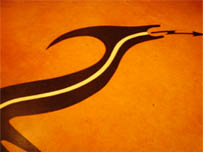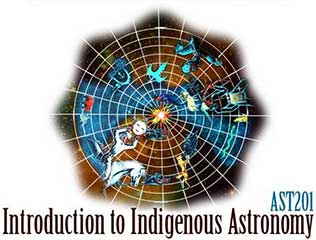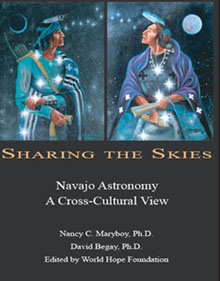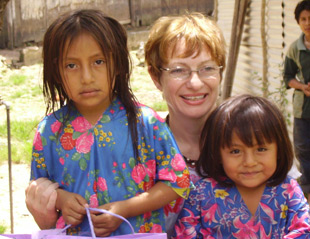Research and Education
 The Cosmic
The CosmicSerpent
IEI specializes in programs related to Indigenous research and education.
We are currently involved in research and education (coming to knowing) in the following areas:
Indigenous Science: IEI conducts research in Indigenous science including: Navajo astronomy; Cherokee astronomy; Juxtapositions of western and Indigenous science with focus on cross-cultural space science and astronomy; Indigenous astronomy around the world; Navajo physics, Indigenous ecology; Local to global environmental balance; Indigenous practices for sustainability; GPS technology.
Example Activities:
- Sharing the Skies,
an educational resource book featuring Navajo, Greek, and NASA Space Science worldviews is based on more than 20 years of research following Indigenous protocol and traditional
western research methods. - AISES-Sponsored Research Conferences, design and implementation of two conferences, at Dine College (formerly Navajo Community College) (Navajo Nation) and in Anchorage, Alaska on the Astronomies, Origins, and Migration of Athabaskan Peoples (Apache, Navajo, Alaskan and Canadian Athabaskan).
- AISES-Sponsored with Vine Deloria, Jr. Sponsored, by invitation, Research Conference on Indigenous Astronomy, pioneering support and participation.
Indigenous Dissertation Archive: Archive of Seminal Work in Indigenous Practice.
Dissertations by IEI Board Members (To order, please contact IEI)
- “Nanit’a Sa’ah Naaghai, Nanit’a Bikeh Hozho,” (Living the Order: The Dynamic Cosmic Process of Dine Cosmology), D. H. Begay and N. C. Maryboy, Doctoral Dissertation (1998).
California Institute of Integral Studies. - “Models of Business,” by VerlieAnn Malina-Wright, Doctoral Dissertation, UCLA
- “The Seven Levels of Conscience of the River People,” Lloyd B. Pinkham, Doctoral Dissertation (1998). California Institute of Integral Studies.
- “Mending the Web: Conflict Transformation Between Aboriginal and Non-Indigenous Australians,” P. O. Walker, Doctoral Dissertation (2001). University of Queensland, Australia.
Indigenous Teaching and Learning: Utilizing effective practice in Indigenous education, IEI researchers and educators engage diverse audiences with Indigenous learning styles using a holistic Indigenous pedagogy in a variety of settings including: Reservation schools, Native Hawaiian Immersion Schools, Native American educational leadership institutes, informal education settings such as museums and community centers, Indigenous higher education institutions, mainstream scientists interested in exploring diverse worldviews of science, and other Indigenous and mainstream education and research
institutions.
Example Activities:
- Dome shows and presentations with NASA Goddard at STAR School and Puente de Hozho School, Flagstaff, AZ, 2013.
- Professional development workshops for Cosmic Serpent museum personnel participants, in the Southwest, Northwest, and California regions (2008-2013).
- Dialogues between Indigenous Knowledge Holders and Scientists (1992-2006) sponsored by Fetzer Institute (Banff, Canada), Center for Particle Astrophysics (UC Berkeley),
and SEED Graduate Institute (Albuquerque, NM) – Dialogues on the Intersection of Western Science and Indigenous Ways of Knowing. - Tribal College Science Classes at Dine College (formerly Navajo Community College); North West Indian College; and Southwest Polytechnic Institute (SIPI).
- K-12 Science Classes at Union Gap Elementary School, Union Gap, WA; and Kula Kaipuni O Anuenue (Native Hawaiian Immersion School), Honolulu Hawaii.
- SEED Graduate Institute (Albuquerque, NM), Indigenous Science Workshop Design and Implementation.
- One Earth, One Universe professional development for NASA scientists and educators on multi-cultural perspectives of science.
- Workshops for Informal educators at Astronomical Society of the Pacific Conferences.
- Professional Development on Traditional Indigenous uses of GIS/GPS technologies; NSF Eagle Vision Grant.
- Professional development workshops to science teachers and students of Bureau of Indian Affairs schools.
- Workshops for Educators, School Boards, and Administrators including New Mexico Science Teachers; Utah Science Teachers, Utah Title 7 Teachers, Navajo Nation Science Teachers, and NASA Explorer Schools.
- Presentations and use of the Starlab to K-12 schools, Museums, and Community Centers at national and international professional conferences such as AISES (Anchorage, Houston) WIPCE (Hawaii, New Zealand, Australia), ASP (Baltimore, St. Louis), NIEA (Albuquerque, Honolulu), CoSpar (Committee on Space Research) Beijing, China, etc.
- Presentations in full dome planetariums on digitized Navajo Astronomy at national and international conferences such as International Planetary Society (IPS) Annual Conference, Adler Planetarium, Chicago, 2008, World Indigenous Peoples Conference on Education (WIPCE), Melbourne, Australia, 2008.
Educational Product Development: IEI develops educational products for the classroom and for informal education venues, such as museums and planetaria, taking into account a multi-cultural perspective of science and other content.
Activities:
- “Sharing the Skies:
Navajo Astronomy – A Cross Cultural View” - “Stars Over Dine
Bikeyah” a CD of Navajo Astronomy - “Navajo Universe”
Poster of Navajo Constellations - “Guidebook to Navajo Astronomy” for
Starlab Portable Planetarium
Use of Technology for Indigenous Education: IEI designs various technology-rich teaching and learning resources, including: Distance learning courses; Use of the Internet to teach with culturally compatible styles and culturally relevant curriculum; Development of indigenous resources for use in informal settings such as museums and planetaria, etc.
Example Activities:
- Portable Planetarium (Sky-Skan)
Digital Planetarium and Program - Northern Arizona University Indigenous Astronomy online Distance Learning Course: “Introduction to Indigenous Astronomy” on comparative astronomy as seen through the eyes of Indigenous peoples and western astronomers. The course provides an introduction to ancient and living astronomies of native cultures.
The course is provided through Northern Arizona University’s Distance Learning program.
- “Traditional Indigenous Uses of GIS/GPS Technologies.” Curriculum development for NSF Eagle Vision Grant, BIA Teachers and Students, delivered at Laguna Pueblo Department of Education
- Mixed media presentations to national and international professional conferences, e.g. AISES, NIEA, WIPCE, COSPAR, ASP, CASTS, etc.
Indigenous Language and Culture Preservation with Application: Navajo high language and consciousness, Navajo cosmology, Application of Navajo cosmology to contemporary educational and community settings, Navajo healing philosophies, Navajo psychology. Navajo cultural work is done in consultation with Navajo Medicine Men Association. Other work in areas of language and culture preservation include: work with Native Hawaiian immersion schools, Yakama Nation culture presentations, Cherokee Nation culture presentations, Conflict Resolution and Transformation from Indigenous perspective.
Indigenous Strategic Planning and Evaluation
IEI specializes in Planning and Evaluation services to Indigenous and non-Indigenous organizations.
IEI has developed process models of strategic planning and evaluation based on Navajo cosmology and traditional teachings, which have been used successfully for more than
15 years on the Navajo Nation. IEI provides customized planning, evaluation, and project administration services based on community needs, traditional culture and language, and through development of Indigenous process models. IEI designs and delivers customized professional development training for Indigenous organizations, leading to IEI Evaluation
Certification. Sustainability is assured through informal and ongoing support systems.
Dine Strategic Planning Based on Navajo Language and Philosophy:
-
- Development of cultural planning models from Indigenous, place-based cultures, languages and cosmologies.
- Strategic Planning for Cosmic Serpent, a National Science Foundation Project
- “Space Science for Seven Generations” Program for World Hope Foundation (Boulder, CO) and the W.K. Kellogg Foundation.
- Strategic Advising for NASA Sun-Earth Connection Education Forum (NASA/GSFC and Space Sciences Laboratory, UC Berkeley).
Indigenous Evaluation:
-
- Ongoing training and consulting to Native organizations in areas of strategic planning and evaluation based on local culture and language. IEI provides consultation in, and implementation of, emergent, formative, and summative evaluations.
- Developed Indigenous Planning and Evaluation Institute (White Rocks, UT, Navajo Nation), for curriculum, training, certification and ongoing support in area of Indigenous
planning and evaluation. - American Indian Evaluation Institute (Duluth, MN), development of curriculum and teaching methodology for Indigenous planning and evaluation course for local communities and organizations from several states (MN, ND, SD, and WI).
- SEED Graduate Institute (Albuquerque, NM), development of indigenous course of study and curriculum based on Navajo cosmology.
Project Design and Administration:
-
- IEI provides consultation services to organizations on: Project Administration; Ongoing Evaluation for Success and Accountability; Grant-Writing Assistance for Winning Proposals; and other services.
- National Center for Biodefense Communications, Jackson State University, Jackson, MS for the Department of Justice program “Applying Remote Sensing and Geographic Information Systems Technology to Law Enforcement Operations in the State of Mississippi,” development and implementation of evaluation plan.
- National Center for Biodefense Communications, Jackson State University, Jackson, MS for the Department of
Energy program “ALL HAZ First Responder Training,” development and implementation of evaluation plan.
Publications
 Sharing
Sharingthe Skies Resource Book
IEI publishes on an ongoing basis in various peer-reviewed journals, magazines, books, etc. including: World Indigenous Nations Higher Education Consortium (WINHEC), World
Indigenous Peoples Conference in Education (WIPCE) Proceedings, Journal of Medical Anthropology, etc.
- Sharing the Skies: Navajo Astronomy, A Cross-Cultural View, resource book featuring Navajo, Greek, and NASA Space Science worldviews.
- “Paradox and Transformation.” World Indigenous Nations Higher Education Consortium, Volume 2, 2006, by N. C. Maryboy, D. H. Begay and L. Nichol.
- “Ways of Knowing from Father Sky: Native and Western Research Protocols From Paradox to Collaboration.” WIPCE
Conference Proceedings, 2005, by N. C. Maryboy, D. H. Begay, I. Hawkins, and T. Cline. - “Finding the Thunderbird in Navajo Astronomy,” Viewing the Sky Through Past and Present Cultures, Selected Papers from the Oxford VII International Conference on Archeoastronomy, 2006.
- “Restoration of Dynamic Balance: Traditional Ways of Healing Expressed Through Navajo Consciousness,” Integrating the Wisdom of the Worlds Healing Systems, Consciousness and Healing: Integral Approaches to Mind-Body Medicine. By M. Schlitz and T. Amorok, M. S. Micozzi. Elsevier Inc., Insititute of Noetic Science, 2005.
- “The Navajos,” The History of Utah’s American Indians. eds. F. S. Cuch. Utah State Division of Indian Affairs/Utah’s Division of State History, 2000.
- The Navajos, International Olympic Committee, Lausanne, Switzerland, 2003
 Dr. Isabel Hawkins
Dr. Isabel Hawkinsand childrenin Bonampak, Chiapas, Mexico
